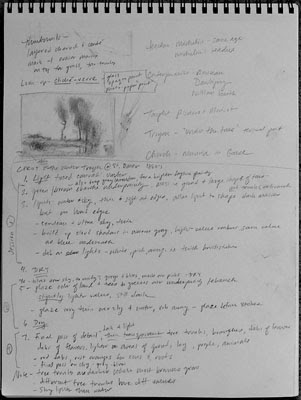Painting outdoors is inspiring, beautiful, centering, and so adrenaline-rushing as to be addictive!
However, it is also uncomfortable, frustrating, full of distractions, and when your umbrella topples your easel over in a breeze, exceptionally maddening.
I have finally assembled a setup I find to be ideal - a good balance of lightweight, sturdy, and flexible:
- Open Box M pochade box 10x12
- Julienne painter's umbrella
- Manfrotto tripod with joystick head
- Manfrotto jointed arm that clamps directly to the tripod and holds the umbrella securely at any angle, with clamps at either end for grasping the easel and the umbrella handle. NOTE: Amazon sells the arm, but not the clamps, so call Open Box M to order through them.
- I also have a lightweight walking cane that folds open into a small stool, which I got here at Bed Bath and Beyond
- I also find these small things essential:
Seal-able solvent can
Viewfinder
- This accessory I have not bought yet, but I see how it could come in handy
This is how I pack it:
Instead of carrying around tubes of oil paint, I load up my Open M pallete with fresh nuggets of paint before I leave for the day. Sometimes I pack a small tube of white, if it's going to be a long day out.
I can fit my Open M pochade box, brushes, and solvent can in a backpack or shoulder bag, along with paper towels, lunch, etc.
Instead of carrying around tubes of oil paint, I load up my Open M pallete with fresh nuggets of paint before I leave for the day. Sometimes I pack a small tube of white, if it's going to be a long day out.
I can fit my Open M pochade box, brushes, and solvent can in a backpack or shoulder bag, along with paper towels, lunch, etc.
The tripod, cane, Manfrotto arm, and umbrella I lash together with 2 short bungee cords. All those things combined are not very heavy, and I can carry it by the cane handle, or under my arm easily. For a long hike I might get a strap for it so I can carry it on my back.
Travelling with oil paints
I have traveled now many times with oil paint, and despite the horror stories we have all heard about having oil paints confiscated, I have never had a problem with this procedure:
Here is what I do:
I have traveled now many times with oil paint, and despite the horror stories we have all heard about having oil paints confiscated, I have never had a problem with this procedure:
Here is what I do:
- Download and print a couple "material safety data sheets" (MSDS) which describe the contents of the paint - there's a different sheet for every color, but I just choose 2 or 3 and print those. Each manfacturer writes up and makes data sheets available online as PDF for all their colors, just google search one your paint brands and a color name with the phrase "material safety data sheets" and you'll find it.
Here is a list of links to of many of the of MSDS paint brands
- Print out a sign with big font that says:
These are vegetable oil based artists materials.
They are not flammable.
Data sheets enclosed.
DO NOT USE THE WORD "PAINT". The word paint is a big problem.
- Fold the MSDS sheets and the sign together so the big message shows up on top.
- Put all the tubes of oil paint in a gallon-sized heavy duty ziplock, and put in the folded packet of sheets so the sign is visible through the plastic bag. Make sure every tube is tightly-capped and there are not any holes in any of the tubes, the pressure changes during the flight will make a mess of any leaky tubes.
- Place the bag near the top of your suitcase with the sign-side up so it's immediately accessible if security searches my bag. (I always get that little note saying they searched my bag, but my paint has never been confiscated.)
- Check the bag. I wouldn't try to bring paints on board.
- I also packed a tiny tin of the "natural turpenoid" (in the GREEN can) along with my painting supplies in my checked bag, to use as my medium. It says non-flammable very clearly right on the tin. I wouldn't use it as a medium in major paintings, but for sketches and all prima work while travelling it's probably fine.
- I wouldn't bring any solvents, oils, mediums, or any kind of mysterious liquids in bottles. I usually buy those or borrow them when I arrive
- Finally: Don't forget your palette knife! :)
Hope that helps! It would be terrible if the paints got confiscated and that's always a risk, so I can't guarantee it will be fine, but it's worked for me.

































 My husband and I drove down to Santa Barbara for the weekend to see the current exhibit at the
My husband and I drove down to Santa Barbara for the weekend to see the current exhibit at the 





 Utah is just incredibly gorgeous and I spent most the 5 days with my mouth agape while admiring the dramatic displays of alternating mist and sunlight rolling off the mountains.
Utah is just incredibly gorgeous and I spent most the 5 days with my mouth agape while admiring the dramatic displays of alternating mist and sunlight rolling off the mountains.









